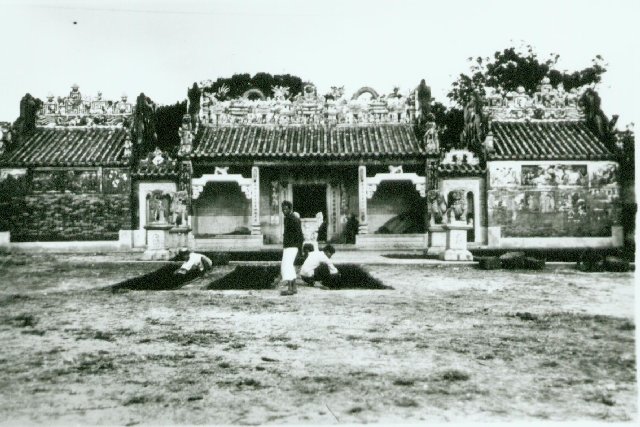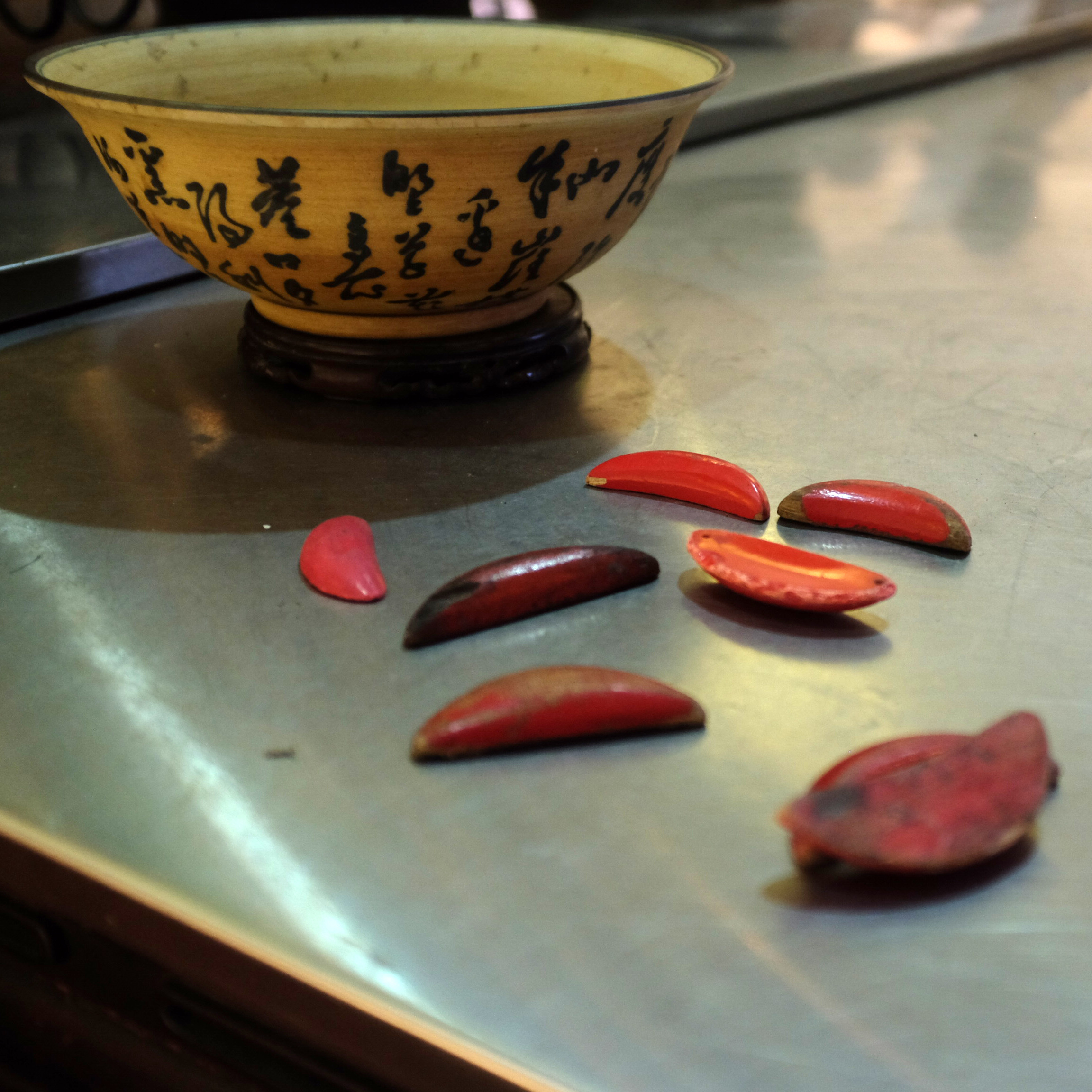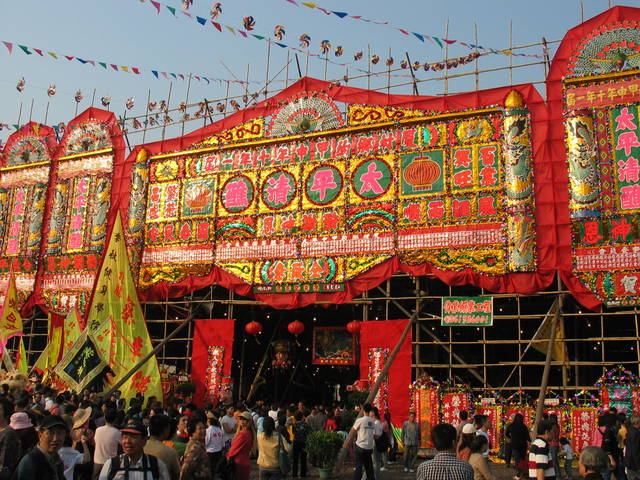|
Yuk Hui Temple
Yuk Hui Temple () also known as Pak Tai Temple (), is a Taoist temple located on the island of Cheung Chau, Hong Kong. The temple address is Pak She Street, Tung Wan, Cheung Chau. Introduction The temple is listed as a Grade I historic building. It is most famous for the Cheung Chau Bun Festival, which is a Taoist ceremony held annually on Cheung Chau island. The festival takes place on the 8th day of the fourth month of the lunar calendar, which occurs usually in April or May. The festival lasts for seven days. It attracts many tourists and Pak Tai worshipers. History The first settlers in Cheung Chau were fishermen from Huizhou, Guangzhou and Chaozhou. They worshiped the Taoist Sea God, Pak Tai, as their patron deity. In 1777, there was a severe outbreak of plague in Cheung Chau. It is said that when a Huizhounese brought a statue of Pak Tai to the island the pestilence miraculously disappeared. In gratitude for Pak Tai's blessing, the residents, led by Mr. Lam Yuk ... [...More Info...] [...Related Items...] OR: [Wikipedia] [Google] [Baidu] |
Taoism
Taoism (, ) or Daoism () refers to either a school of Philosophy, philosophical thought (ķüōÕ«Č; ''daojia'') or to a religion (ķüōµĢÖ; ''daojiao''), both of which share ideas and concepts of China, Chinese origin and emphasize living in harmony with the ''Tao'' (, 'Thoroughfare'); the ''Tao'' is generally defined as the source of everything and the ultimate principle underlying reality. The ''Tao Te Ching'', a book containing teachings attributed to Laozi (), together with the later Zhuangzi (book), writings of Zhuangzi, are both widely considered the keystone works of Taoism. Taoism teaches about the various disciplines for achieving perfection through self-cultivation. This can be done through the use of Taoist techniques and by becoming one with the unplanned rhythms of the all, called "the way" or "Tao". Taoist ethics vary depending on the particular school, but in general tend to emphasize ''wu wei'' (action without intention), naturalness, simplicity, spontaneity and the ... [...More Info...] [...Related Items...] OR: [Wikipedia] [Google] [Baidu] |
Chaozhou
Chaozhou (), alternatively Chiuchow, Chaochow or Teochew, is a city in the eastern Guangdong province of China. It borders Shantou to the south, Jieyang to the southwest, Meizhou to the northwest, the province of Fujian to the east, and the South China Sea to the southeast. It is administered as a prefecture-level city with a jurisdiction area of and a total population of 2,568,387. Its built-up (or metro) area encompassing most of Shantou and Jieyang cities was home to 12,543,024 inhabitants on 13 local administrative areas. Along with Shantou and Jieyang, Chaozhou is a cultural center of the Chaoshan region. History In 214 BC, Chaozhou was an undeveloped part of Nanhai Commandery () of the Qin Dynasty. In 331 during the Eastern Jin Dynasty, Haiyang () was established as a part of Dongguan Commandery (). The Dongguan Commandery was renamed Yi'an Commandery () in 413. The commandery became a prefecture in 590 during the early Sui Dynasty, first as Xun Prefecture (), then as ... [...More Info...] [...Related Items...] OR: [Wikipedia] [Google] [Baidu] |
Sedan Chair
The litter is a class of wheelless vehicles, a type of human-powered transport, for the transport of people. Smaller litters may take the form of open chairs or beds carried by two or more carriers, some being enclosed for protection from the elements. Larger litters, for example those of the Chinese emperors, may resemble small rooms upon a platform borne upon the shoulders of a dozen or more people. To most efficiently carry a litter, porters either place the carrying poles directly upon their shoulders or use a yoke to transfer the load from the carrying poles to the shoulders. Definitions A simple litter consists of a sling attached along its length to poles or stretched inside a frame. The poles or frame are carried by porters in front and behind. Such simple litters are common on battlefields and emergency situations, where terrain prohibits wheeled vehicles from carrying away the dead and wounded. Litters can also be created quickly by the lashing of poles to a chair ... [...More Info...] [...Related Items...] OR: [Wikipedia] [Google] [Baidu] |
Princess Margaret
Princess Margaret, Countess of Snowdon, (Margaret Rose; 21 August 1930 ŌĆō 9 February 2002) was the younger daughter of King George VI and Queen Elizabeth The Queen Mother, and the younger sister and only sibling of Queen Elizabeth II. Margaret was born when her parents were the Duke and Duchess of York, and she spent much of her childhood with them and her elder sister. Her life changed at the age of six, when her father ascended the British throne following the abdication of his brother Edward VIII. Margaret's sister became heir presumptive, with Margaret second in line to the throne. Her position in the line of succession diminished over the following decades as Elizabeth's children and grandchildren were born. During the Second World War, the two sisters stayed at Windsor Castle despite suggestions to evacuate them to Canada. During the war years, Margaret was too young to perform official duties and continued her education, being nine years old when the war ... [...More Info...] [...Related Items...] OR: [Wikipedia] [Google] [Baidu] |
East Kowloon
Kowloon East is the eastern part of Kowloon, covering the Wong Tai Sin and Kwun Tong District, with Kowloon City District occasionally included. History The boundary of Kowloon East is not strictly defined and hence varies. While traditionally the KowloonŌĆōCanton Railway (now the East Rail line) serves as the separation of eastern and western part, the Kowloon City District, located at the east of the railway, was part of the Kowloon West Legislative Council constituency in order to balance the population between the two halves. Nevertheless, the Kwun Tong District has long been regarded as the part of Kowloon East, while Wong Tai Sin District is sometimes seen as either in Kowloon Central or Kowloon East. Naming of Kowloon East can be seen in the planned East Kowloon line which connects Diamond Hill to Sheung Wan via East Kowloon neighbourhoods, and East Kowloon Corridor which links Kai Tak to Hung Hom. In 1985, "Kowloon City", " Kwun Tong" and "Wong Tai Sin" electoral-colle ... [...More Info...] [...Related Items...] OR: [Wikipedia] [Google] [Baidu] |
Jiaobei
Moon blocks or ''jiaobei'' (also written as ''jiao bei'' etc. variants; ), also ''poe'' (from ; as used in the term " ''poe'' divination"), are wooden divination tools originating from China, which are used in pairs and thrown to seek divine guidance in the form of a yes or no question. They are made out of wood or bamboo and carved into a crescent shape. A pair of clam shells can also be used. Each block is round on one side (known as the ''yin'' side) and flat on the other (known as the ''yang'' side). It is one of the more commonly used items found in Chinese traditional religion and are used in temples and home shrines along with fortune sticks, both of which are often used together when requesting an answer from the Deities. Practice Moon blocks can be used separately to receive a straightforward answer, or they are accompanied by fortune sticks to clarify an oracle. When used alone, moon blocks are first purified by revolving the blocks around the incense burner three ti ... [...More Info...] [...Related Items...] OR: [Wikipedia] [Google] [Baidu] |
Japanese Occupation Of Hong Kong
The Imperial Japanese occupation of Hong Kong began when the Governor of Hong Kong, Mark Aitchison Young, Sir Mark Young, surrendered the British Crown colony of British Hong Kong, Hong Kong to the Empire of Japan on 25 December 1941. The surrender occurred after Battle of Hong Kong, 18 days of fierce fighting against the overwhelming Imperial Japanese Army, Japanese forces that had invaded the territory.Snow, Philip. [2004] (2004). The fall of Hong Kong: Britain, China and the Japanese occupation. Yale University Press. , .Mark, Chi-Kwan. [2004] (2004). Hong Kong and the Cold War: Anglo-American relations 1949ŌĆō1957. Oxford University Press publishing. , . p 14. The occupation lasted for three years and eight months until Surrender of Japan, Japan surrendered at the end of the World War II, Second World War. The length of this period (, ) later became a metonym of the occupation. Background Imperial Japanese invasion of China During the Imperial Japanese military's Second ... [...More Info...] [...Related Items...] OR: [Wikipedia] [Google] [Baidu] |
Emperor Bing Of Song
Zhao Bing (12 February 1272 ŌĆō 19 March 1279), also known as Emperor Bing of Song or Bing, Emperor of Song (Õ«ŗÕĖصś║), was the 18th and last emperor of the Song dynasty of China, who ruled as a minor between 6 and 7 years of age. He was also the ninth and last emperor of the Southern Song dynasty. He reigned for around 313 days in 1278 and 1279. His reign, and the Song dynasty, ended with the Song's total defeat by the Yuan dynasty at the naval Battle of Yamen. Zhao Bing and his entourage had been observing the naval combat from some coastal cliffs nearby. As the victorious enemy approached, Lu Xiufu seized the emperor and leaped from the clifftops, killing them both. Early life Zhao Bing was the seventh son of Zhao Qi (Emperor Duzong). His mother was Lady Yu (õ┐×µ░Å), a concubine of Emperor Duzong who held the rank of ''xiurong'' (õ┐«Õ«╣). He was a younger half-brother of his predecessors, Zhao Xian (Emperor Gong) (r. 1275ŌĆō1276) and Zhao Shi (Emperor Duanzong) (r ... [...More Info...] [...Related Items...] OR: [Wikipedia] [Google] [Baidu] |
Song Dynasty
The Song dynasty (; ; 960ŌĆō1279) was an imperial dynasty of China that began in 960 and lasted until 1279. The dynasty was founded by Emperor Taizu of Song following his usurpation of the throne of the Later Zhou. The Song conquered the rest of the Ten Kingdoms, ending the Five Dynasties and Ten Kingdoms period. The Song often came into conflict with the contemporaneous Liao, Western Xia and Jin dynasties in northern China. After retreating to southern China, the Song was eventually conquered by the Mongol-led Yuan dynasty. The dynasty is divided into two periods: Northern Song and Southern Song. During the Northern Song (; 960ŌĆō1127), the capital was in the northern city of Bianjing (now Kaifeng) and the dynasty controlled most of what is now Eastern China. The Southern Song (; 1127ŌĆō1279) refers to the period after the Song lost control of its northern half to the Jurchen-led Jin dynasty in the JinŌĆōSong Wars. At that time, the Song court retreated south of the ... [...More Info...] [...Related Items...] OR: [Wikipedia] [Google] [Baidu] |
Floorplan Yht
In architecture and building engineering, a floor plan is a technical drawing to scale, showing a view from above, of the relationships between rooms, spaces, traffic patterns, and other physical features at one level of a structure. Dimensions are usually drawn between the walls to specify room sizes and wall lengths. Floor plans may also include details of fixtures like sinks, water heaters, furnaces, etc. Floor plans may include notes for construction to specify finishes, construction methods, or symbols for electrical items. It is also called a ''plan'' which is a measured plane typically projected at the floor height of , as opposed to an ''elevation'' which is a measured plane projected from the side of a building, along its height, or a section or ''cross section'' where a building is cut along an axis to reveal the interior structure. Overview Similar to a map, the orientation of the view is downward from above, but unlike a conventional map, a plan is drawn at a part ... [...More Info...] [...Related Items...] OR: [Wikipedia] [Google] [Baidu] |
Tai Ping Ching Chiu
Dajiao, ()''New Journey Through History 1A''. Kan, Nelson Y. Y. and Tang, Miranda K. L. Published by Aristo Education Press LTD. called the Taiping Qingjiao or Taai ping ching jiu in Hong Kong, () is a Taoist ritual and festival which is performed every year. The ritual is to pray and request the Taoist Deities to bestow peace and harmony in the particular neighborhood or location. Pak Tai is the most popular Chinese Deity for this religious service and rituals. Believers have to abstain from meat and eat vegetarian food at the festival. It is performed across Greater China: Sichuan, Fujian, Taiwan, Guangdong and Hong Kong. Hong Kong The festival name is transliterated as Tai Ping Ching Chiu from Cantonese. Some of these festivals are called Da Jiu Festival, a famous one of which is the Cheung Chau Bun Festival Cheung Chau Bun Festival or Cheung Chau Da Jiu Festival is a traditional Chinese festival on the island of Cheung Chau in Hong Kong. Held annually, and with therefore ... [...More Info...] [...Related Items...] OR: [Wikipedia] [Google] [Baidu] |
Chinese Calendar
The traditional Chinese calendar (also known as the Agricultural Calendar Š▓µøå; Õå£ÕÄå; ''N├│ngl├¼''; 'farming calendar' Former Calendar łŖµøå; µŚ¦ÕÄå; ''Ji├╣l├¼'' Traditional Calendar Ćüµøå; ĶĆüÕÄå; ''LŪÄol├¼'', is a lunisolar calendar which identifies years, months, and days according to astronomical phenomena. In China, it is defined by the Chinese national standard GB/T 33661ŌĆō2017, "Calculation and Promulgation of the Chinese Calendar", issued by the Standardization Administration of China on May 12, 2017. Although modern-day China uses the Gregorian calendar, the traditional Chinese calendar governs holidays, such as the Chinese New Year and Lantern Festival, in both China and overseas Chinese communities. It also provides the traditional Chinese nomenclature of dates within a year which people use to select auspicious days for weddings, funerals, moving or starting a business. The evening state-run news program ''Xinwen Lianbo'' in the P.R.C. continues to anno ... [...More Info...] [...Related Items...] OR: [Wikipedia] [Google] [Baidu] |










